p.83
p.87
p.93
p.99
p.105
p.111
p.117
p.123
p.128
The Simplified Method to Calculate Two-Dimensional Heat Conduction Equations of Heating Slab
Abstract:
The most effective way of determining the whole billet temperature field is to use a simulation model. Large amount of calculation as well as computational time is consumed to employ two-dimensional finite difference method since the heating process is extremely complex, then it’s necessary to simplify the calculation process. In this paper, a simplified method in one-dimension format was presented to calculate two-dimensional heat conduction equations of heating slab. The billet simulated was placed in a changeable thermal flux boundary environment, in which the thermal flux was proportional to fourth power of temperature. During the heating process, the changeable parameters were taken into account: i. e different billet dimensions, different billet thermal conduction, different specific heat, etc. The comparision between results of two-dimensional finite difference method and the simplified method verified that the simplified method can satisfy accuracy requirement as well as calculation time saving, which enable the simplified method online using.
Info:
Periodical:
Pages:
105-110
Citation:
Online since:
July 2011
Authors:
Price:
Сopyright:
© 2011 Trans Tech Publications Ltd. All Rights Reserved
Share:
Citation:


